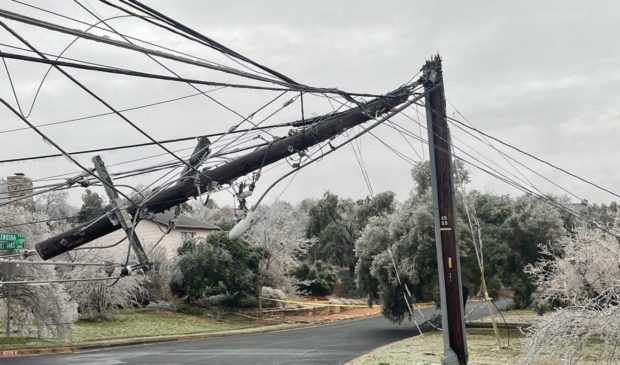Ice storm damage to get Council attention at Tuesday work session
Monday, February 6, 2023 by
Chad Swiatecki Tuesday’s City Council work session looks like it will be heavily focused on discussion about the impact of last week’s ice storm, which disrupted power to more than 250,000 people at some point during the three-day freeze.
The city and Travis County signed emergency declarations over the weekend, potentially opening up federal resources to help in the cleanup of thousands of downed and damaged trees that buckled under the weight of accumulated ice, taking down power and communications lines throughout the area. As of Sunday afternoon there were still more than 1,500 outages – or more than 36,000 customers – being managed by Austin Energy crews working 12-hour shifts.
The Tuesday meeting will include extensive updates from Austin Energy staff, the Public Works Department and Resource Recovery, which are all involved in the restoration of power service and the cleanup efforts.
There will also be discussion about a possible audit of Austin Energy, which has been proposed by Council Member Mackenzie Kelly with support from Council members Ryan Alter and José Velásquez. The audit would examine the utility’s vegetation management plans and its overall response to the storm.
On the City Council Message Board, Kelly wrote: “As policymakers, one way we can take action for the community is to investigate Austin Energy’s vegetation management plan and how they handle extreme weather events and locate areas to make improvements to current operations. Finding places for improvement will increase resiliency for the whole community.”
At a Sunday press conference, Jackie Sargent, AE’s general manager, said the widespread nature of storm damage makes further restorations time-consuming and difficult. With high winds and rain expected Tuesday, staff said there could be further damage caused by weakened trees giving way in strong winds.
“Our restorations will continue until every single customer is back online …. We are still dealing with hurricane-level devastation,” she said. “I really wish we could give you an estimated time of restoration. This is frustrating for everyone and we know that it’s difficult for customers to plan without information. Unfortunately the severity and complexity of ice storm damage hasn’t led to that.”
Council Member Leslie Pool, chair of the Austin Energy Utility Oversight Committee, said she wants to hold off on the audit Kelly is proposing and instead let AE staff complete an after-action report that can be discussed at the committee’s next meeting on Feb. 21.
“I don’t know what the scope would be, and I don’t think it’s responsible to call for something when we might miss a really obvious area that we need to investigate and look at. Our haste to make some kind of large statement using an audit that way is, I don’t think, called for at this point,” she said. “An audit is a great idea. Austin Energy is going to be pretty clear on where they see their improvements will be necessary, and the Council can probe that and challenge it and look for different areas to make improvements, go deeper, but I don’t think we’re ready for it yet.”
Pool said she agreed with Mayor Kirk Watson’s recent assessment that the city should have been more proactive in holding press events to update residents on the extent of damage and progress being made to restore power and other infrastructure like traffic signals. She said improvements need to be made to AE’s outage map that will let customers know their outage is being tracked without making public what homes are dark and could become targets for criminal activity.
On the possibility of burying power and communications lines underground, Pool said the cost to retrofit existing lines – starting at $1 million per mile according to state utilities experts – has always been seen as prohibitive, but may need to be reexamined as weather-related disasters continue to impact the city.
“It’s super expensive to retrofit, and you have to say, here’s how much it would be with the cost-benefit analysis to see, is this something the community wants?” she said. “We have to ask, what do we do to harden all of this so that the next time it happens, because we know with climate change the pace will continue to occur. That’s the policy question: How much and at what cost?”
Watson, who is quarantined with Covid but stays in communication with city staff regarding the recovery process, said Austin Energy’s pace in conducting tree trimmings following recently revised standards will be one area of questioning in the months to come. Via email, he also acknowledged that the city fell short when it came to communicating important news to residents.
“While this was the worst ice storm in Austin since at least 2007, it was not the first weather-related crisis our city has faced in the last 16 years. Yet time and time again, the city has failed in communicating with our citizens before and during these events. As of right now, about 35,000 customers are still without power. For many, that is five days of cold, stress, anxiety, anger, fear, and loss. Keeping the power and lights working is a basic function of city government, but so is accurate and effective communication. We can and will do better.”
The Austin Monitor’s work is made possible by donations from the community. Though our reporting covers donors from time to time, we are careful to keep business and editorial efforts separate while maintaining transparency. A complete list of donors is available here, and our code of ethics is explained here.
You're a community leader
And we’re honored you look to us for serious, in-depth news. You know a strong community needs local and dedicated watchdog reporting. We’re here for you and that won’t change. Now will you take the powerful next step and support our nonprofit news organization?









